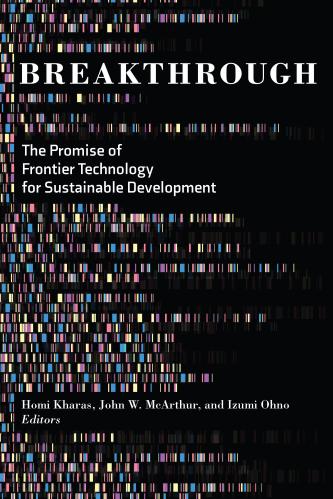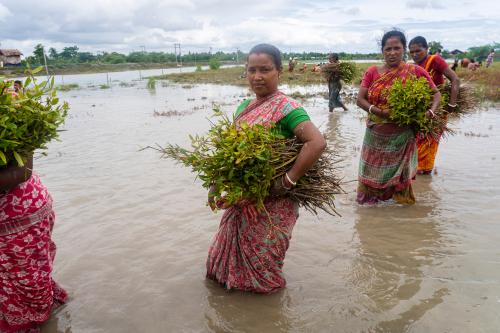In this blog, Homi Kharas interviews writer and technologist Jonathan Ledgard about his proposal for interspecies money, recently published in the book “Breakthrough: The promise of frontier technologies for sustainable development.”
Homi Kharas: With all the problems facing us now—climate change, inequality, the pandemic, extreme poverty—is biodiversity a top global priority?
Jonathan Ledgard: The 2020s will likely be the most consequential decade for nonhuman life in recorded history. We are facing, in our lifetimes, a sixth mass extinction event in the last 500 million years. Tens of thousands of species are at threat of total or local extinction. There are half as many wild animals alive today as there were in 1970. On the captive side, the biomass of chickens exceeds that of wild birds, and the biomass of humans and livestock is 25 times that of all wild animals on land.
HK: In our capitalist system, only $24 billion is spent globally on the conservation of nature, while $97 billion is spent just on pet food. What can be done?
JL: I propose a new central bank, something futuristic and beyond the GEF [Global Environment Facility] and other existing finance mechanisms: a Bank for Other Species in which the bank serves nonhuman life forms. The bank will be empowered to create a central bank digital currency and disburse it to the digital proxies of rare animal, tree, and even insect species. This currency, the life mark (L-marks), will gain regulatory approval in most countries in the world. It will be possible for poorer communities to earn L-marks as payment for services they provide to the other species.
HK: How do you decide on what to conserve? Do you give priority to where the risk of extinction is highest?
JL: There are instances where we can accurately calculate the existence value of a given species in a given ecosystem and economy. For example, studies suggest that each African elephant contributes a notional $1.75 million, while the tusks of a dead elephant fetch only $40,000, and other studies that dugongs are worth $132,000 alive, against less than $1,000 for meat when they are killed. Similarly, the contribution trees, soil biomes, and whales make to carbon capture can now be priced. However, our knowledge of the nonhuman world is far too patchy for a comprehensive allocation of resources. Only 2 million of 8.7 million species on Earth are recorded by science. Only 45,000 of the 1 million or so mites—and only 100,000 of the 3 million fungi—have been recorded. We know these beings have value within complex living systems—nature might contribute as much as $40 trillion annually to the global economy–but the issuance of L-marks to them cannot be made alone on economic grounds. At some point, the economics of biodiversity becomes as meaningless as the economics of the entire biosphere.
HK: How would interspecies money work?
JL: Interspecies money is made possible today because of the collapse in the cost of gathering data in the wild thanks to low-cost sensors, drones, and other robots, near space observation, and especially eDNA sampling, coupled with huge strides in artificial intelligence that can interpret this data. Taken together, this combination permits us to base the allocation of interspecies money on actual conservation results. Face recognition of primates exceeds 95 percent accuracy, often advanced by algorithms used for recognizing individual pigs and sheep. A secure digital identity based on the distinctive markings of animals is well advanced as is the remote identification of whales at sea.
Once you can reliably identify individual species in their habitats, conservationists can self-organize around the new digital currency to greatly extend their knowledge. For example, the International Barcode of Life wants to identify a further 2 million species in the next decade. Observation of new species can be rewarded in L-marks exchangeable for U.S. dollars. Instead of mining numbers, as in Bitcoin, they will be mining life discovery.
HK: Can you give a more specific example of how this could work in practice?
JL: I use the giraffe as a Sesame Street example. There are 117,000 giraffes left alive in the wild, down from 163,000 in 1985. A further 1,700 live in captivity. In some places, giraffe numbers have collapsed by 95 percent owing to habitat fragmentation, the incursion of farmers, and bovine tuberculosis. Giraffes are also hit by cars, killed for meat, bone marrow, and for their tails (which are used for ceremonial purposes).
Imagine each giraffe held a wallet with $32,000 equivalent in L-marks (I base this amount on the modeled economic value referenced above). With community rangers, sensors, and AI providing data, it will be possible to autonomously release payments from the giraffe (or its digital twin) for observation and other services: In this case, the giraffe might pay herders to move their cattle away from watering holes; pay villagers to plant more acacia trees for it to graze on; and pay security to protect it from poachers. In short, the incremental payments will build a dataset of unprecedented frequency and resolution, not just useful for giraffes but for a healthy ecosystem more widely.
This perhaps illustrates another point: If funds are allocated to keystone species (such as the literal watchtower giraffe), many other species within these ecosystems will also be supported. The giraffe will help the oxpecker birds and weaver birds; the bees, moths, and other pollinators; and the trees and grasses that are building blocks of the ecosystem.
The giraffes will issue L-marks for as long as results are validated. Very poor local communities will generate the data and provide the services. Of course, real services must be paid for with real money—so villagers need to be able to cash L-marks they earn.
HK: Who stands to benefit?
JL: Biodiversity is richest in the poorest countries in the world: Papua New Guinea, Madagascar, Central African Republic, and the Democratic Republic of Congo stand to benefit the most. I find it interesting that a quarter of the world’s languages are found in the New Guinean, Congolese, and Amazonian rainforests––a wealth of nature supports a wealth of human diversity. Interspecies money can help these cultures hold on to their knowledge and their surrounding ecosystems.
HK: Where will the liquidity come from?
JL: The Bank for Other Species will pool diverse funders. Initially, philanthropists. Amazon founder, Jeff Bezos, has established a $10 billion Earth fund focused on climate change and biodiversity solutions. The fund’s boss, Andrew Steer, says “there are no magic bullets, it’s like a jigsaw puzzle.” The Bank for Other Species, with advanced AI, data management, as well as liquidity, could be a corner piece in the jigsaw. Then, governments: The European Union’s 95 billion-euro Horizon 2021-27 research fund has biodiversity as one priority; similar American and Chinese initiatives exist. Personally, I expect private investment in biodiversity to rocket in the 2020s. Consider that investment into biodiversity is estimated between $6.6 billion to $13.6 billion a year, while loans and underwriting worth $2.6 trillion go to industries driving biodiversity loss. This opens the way for institutional investors to buy many kinds of biodiversity offsets, similar to carbon offsets, but these can only work if there is sufficient data acquisition in the wild to build nature regenerative investment vehicles that are saleable on Wall Street.
HK: What are the challenges to making this happen?
JL: What really matters is acting quickly in order to rewrite the economic rules in favor of nonhuman life in a transparent and accurate way. We need to immediately finance and execute pilot projects in order to test the validity of AI and computational governance elements of interspecies money in the wild. Scientists should be incentivized to research relevant questions such as predation, vagility, and carrying capacity of species. The correct architecture for the Bank for Other Species is critical. Clearly, it should resemble a central bank in stability and trust, but it is likely that cryptocurrency treasuries will move faster than central bankers. Diverting say, 0.3 percent of the largest crypto treasuries directly into L-marks will generate several billion dollars’ equivalent every year and the L-mark will likely appreciate in value. The biggest challenge is not to create something that collapses under its own weight, or inadvertently introduces a panopticon surveillance state into the natural world, nor has unintended or damaging side effects for communities.








Commentary
Financing the preservation of diverse life on Earth in a capitalist system
February 15, 2022